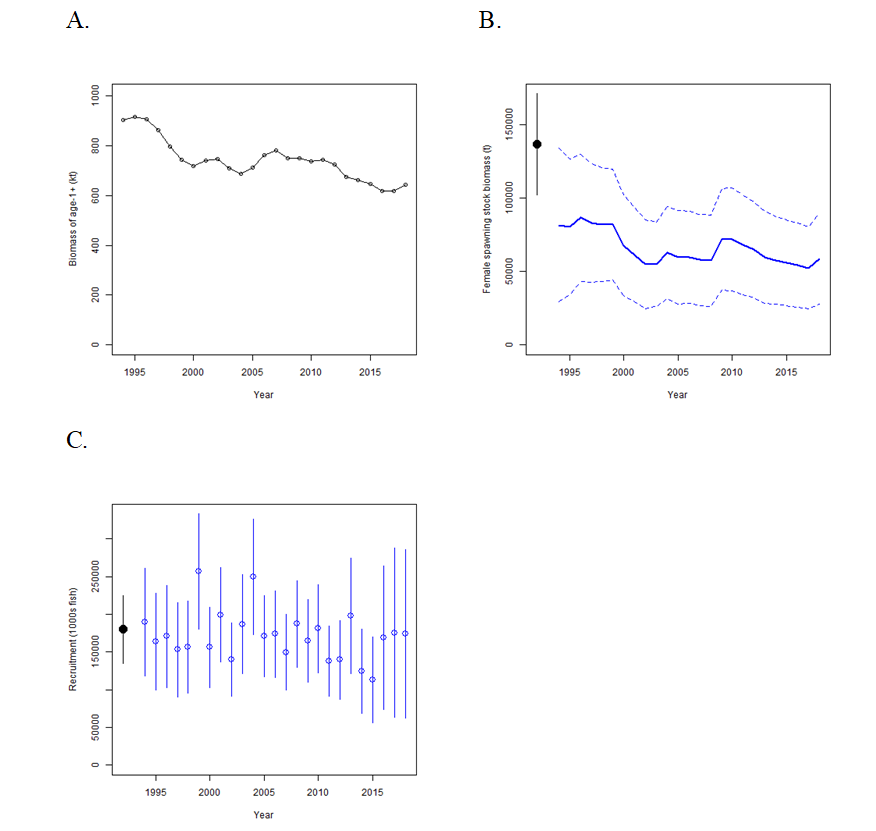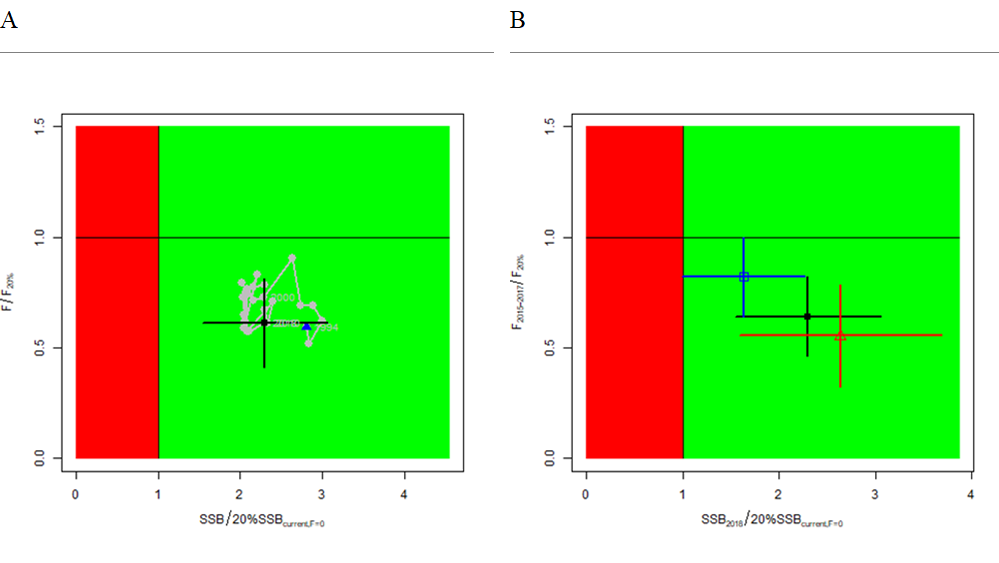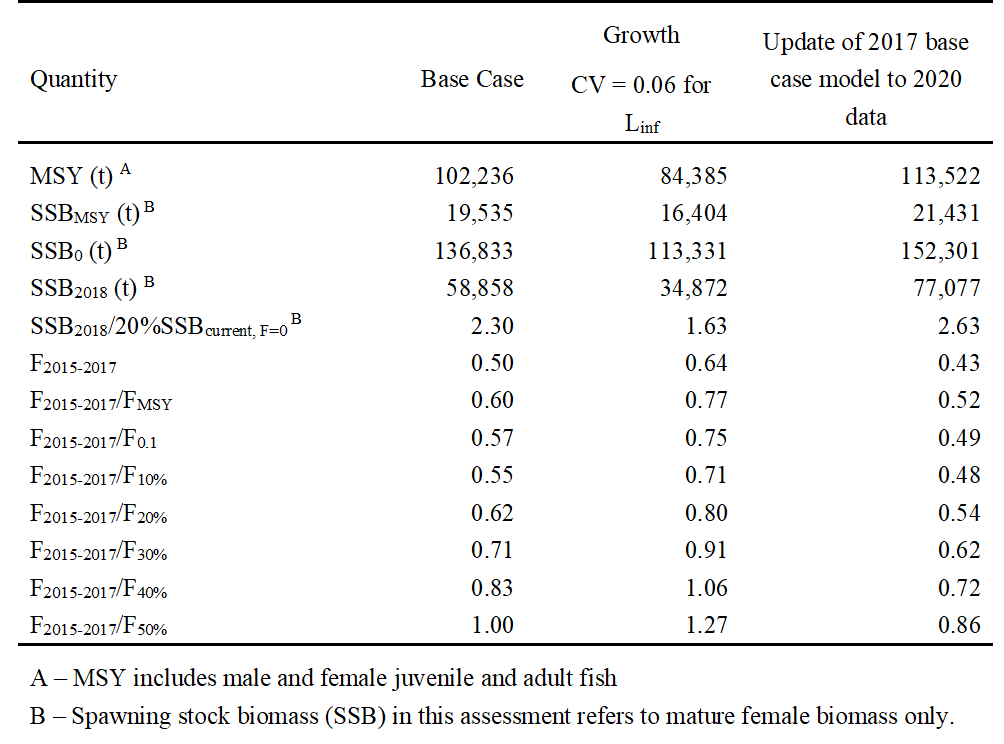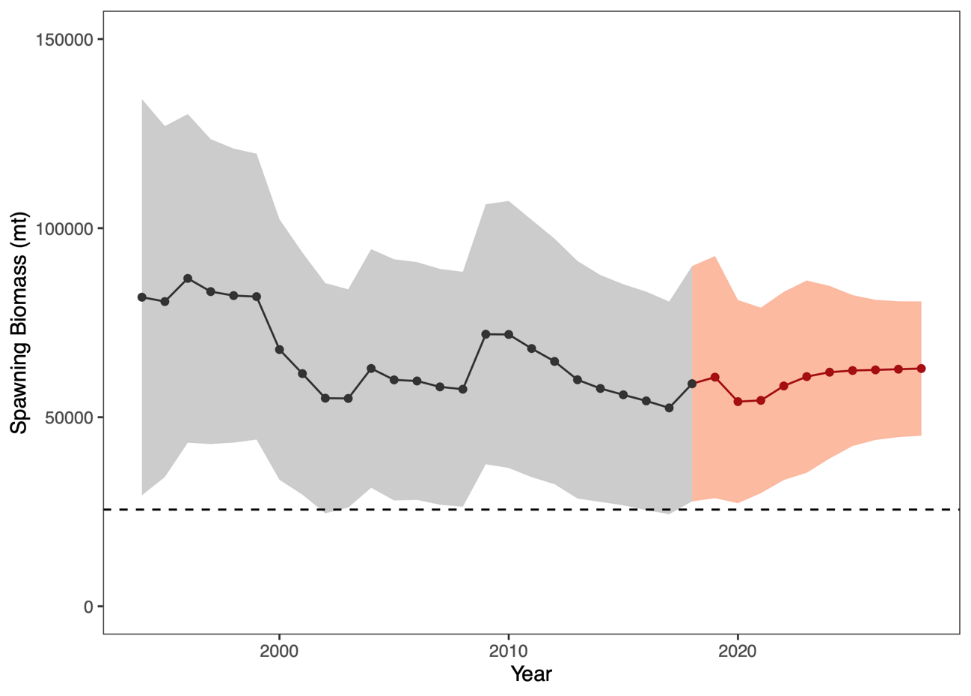Stock Status and Conservation Information
(From ISC20 Plenary Report)
Albacore
The stock status and conservation information adopted by the ISC20 Plenary was endorsed and is reproduced below.
![]() Click here to see the ISC19 stock status and conservation information.
Click here to see the ISC19 stock status and conservation information.
Stock Status
Estimated total stock biomass (males and female at age-1+) declines at the beginning of the time series until 2000, after which biomass becomes relatively stable (Figure 1). Estimated female SSB exhibits a similar population trend, with an initial decline until 2003 followed by fluctuations without a clear trend through 2018 (Figure 1). However, estimated recruitment reached historical lows in 2014 (~125 million fish; 95% CI: 69 E180 million fish) and 2015 (~113 million fish; 95% CI: 56 E170 million fish) (Figure 1, which may have contributed to relatively low catches of fisheries catching juvenile albacore in recent years. It is currently unclear whether recruitment improved after 2015 because recruitment during the terminal years of the assessment (2016 E2018) have large uncertainties (Figure 1).

The estimated average SPR (spawners per recruit relative to the unfished population) during 2015 E2017 is 0.50 (95% CI: 0.36 E0.64), which corresponds to a moderate fishing intensity (i.e., 1-SPR = 0.50). Instantaneous fishing mortality at age (F-at-age) is similar in both sexes through age-5, peaking at age-4 and declining to a low at age-6, after which males experience higher F-at-age than females up to age 12. Juvenile albacore aged 2 to 4 years comprised approximately 70% of the annual catch between 1994 and 2018. The dominance of juveniles is also reflected in the larger impact of surface fisheries (primarily troll, pole-and-line), which remove juvenile fish, relative to longline fisheries, which primarily remove adult fish (Figure 2).

The WCPFC -NC, which manages this stock together with the IATTC, adopted a biomass-based LRP in 2014 of 20% of the current spawning stock biomass when F=0 (20%SSBcurrent, F=0). The 20%SSBcurrent, F=0 LRP is based on dynamic biomass and fluctuates depending on changes in recruitment. This LRP is calculated for NPO ALB as 20% of the unfished dynamic female spawning biomass in the terminal year of this assessment (i.e., 2018) (WCPFC-NC13 Summary Report). However, neither the IATTC nor the WCFPC have adopted F-based limit reference points for the NPO ALB stock.
Stock status is depicted in relation to the LRP (20%SSBcurrent, F=0) for the stock and the equivalent fishing intensity (F20%; calculated as 1-SPR20%) (Figure 3). Fishing intensity (F, calculated as 1-SPR) is a measure of fishing mortality expressed as the decline in the proportion of the spawning biomass produced by each recruit relative to the unfished state. For example, a fishing intensity of 0.8 will result in an SSB of approximately 20% of SSB0 over the long run. Fishing intensity is considered a proxy of fishing mortality.

The Kobe plot shows that the estimated female SSB has never fallen below the LRP since 1994, albeit with large uncertainty in the terminal year (2018) estimates ((Figure 3). Even when alternative hypotheses about key model uncertainties such as growth were evaluated, the point estimate of female SSB in 2018 (SSB2018) did not fall below the LRP, although the risk increases with this more extreme assumption ((Figure 3). The SSB2018 was estimated to be 58,858 t (95% CI: 27,751 E89,966 t) and 2.30 (95% CI: 1.49 E3.11) times greater than the estimated LRP threshold of 25,573 t (95% CI: 19,150 E31,997 t) ((Table 1). Current fishing intensity, F2015-2017 (0.50; 95% CI: 0.36 E0.64; calculated as 1- SPR2015-2017) , was at or lower than all seven potential F-based reference points identified for the NPO ALB stock (Table 1)
1) the base case model;
2) an important sensitivity model due to uncertainty in growth parameters; and
3) a model representing an update of the 2017 base case model to 2020 data.
SSB0 and SSBMSY are the unfished biomass of mature female fish and at MSY, respectively. The Fs in this table are indicators of fishing intensity based on SPR and calculated as 1-SPR so that the Fs reflect changes in fishing mortality. SPR is the equilibrium SSB per recruit that would result from the current year’s pattern and intensity of fishing mortality. Current fishing intensity is based on the average fishing intensity during 2015-2017 (F2015-2017). 20%SSBcurrent, F=0 is 20% of the current unfished dynamic female spawning biomass, where current refers to the terminal year of this assessment (i.e., 2018). The model representing an update of the 2017 base case model is highly similar to but not identical to the 2017 base case model due to changes in data preparation and model structure.

Based on these findings, the following information on the status of the north Pacific albacore stock is provided:
- The stock is likely not overfished relative to the limit reference point adopted by the Western and Central Pacific Fisheries Commission (20%SSBcurrent, F=0), and
- No F-based reference points have been adopted to evaluate overfishing. Stock status was evaluated against seven potential reference points. Current fishing intensity (F2015-2017) is likely at or below all seven potential reference points (see ratios in Table 1).
Conservation Information
Two harvest scenarios were projected to evaluate impacts on future female SSB: F constant at the 2015-2017 rate over 10 years (F2015-2017) and (average of 2013-2017 = 69,354 t) over 10 years. Median female SSB is expected to increase to 62,873 t (95% CI: 45,123 - 80,622 t) by 2028, with a low probability of being below the LRP by 2028, if fishing intensity remains at the 2015-2017 level (Figure 4). If future catch is held constant at 69,354 t, then the female SSB is expected to increase to 66,313 t (95% CI: 33,463 - 99,164 t) by 2028 and the probability that female SSB will be below the LRP by 2028 is slightly higher than the constant F scenario (Figure 5). Although the projections appear to underestimate the future uncertainty in female SSB trends, the probability of breaching the LRP in the future is likely small if the future fishing intensity is around current levels.


Based on these findings, the following information is provided:
- If a constant fishing intensity (F2015-2017) is applied to the stock, then median female spawning biomass is expected to increase to 62,873 t and there will be a low probability of falling below the limit reference point established by the WCPFC by 2028.
- 2. If a constant average catch (C2013-2017 = 69,354 t) is removed from the stock in the future, then the median female spawning biomass is also expected to increase to 66,313 t and the probability that SSB falls below the LRP by 2028 will be slightly higher than the constant fishing intensity scenario.